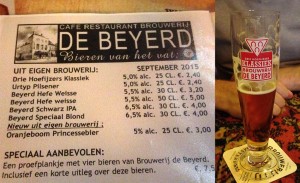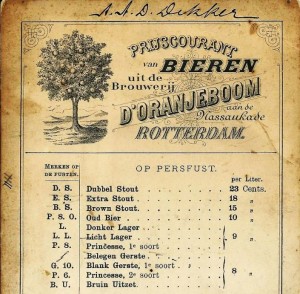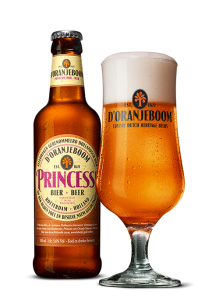Princesse beer by d’Oranjeboom
 And now, I can announce something that I’m really happy about: Princesse beer is back on the market! This historical Dutch beer, for which I had found a recipe from the year 1866, will soon be available across Holland and beyond. To make it even better, this is done under the centuries old Oranjeboom brand, a brewery that produced princesse beer throughout the 19th century. How and why? Read on…
And now, I can announce something that I’m really happy about: Princesse beer is back on the market! This historical Dutch beer, for which I had found a recipe from the year 1866, will soon be available across Holland and beyond. To make it even better, this is done under the centuries old Oranjeboom brand, a brewery that produced princesse beer throughout the 19th century. How and why? Read on…
You may remember that princesse beer was one of the most popular Dutch beer types of the 19th century. It first surfaced at the Dutch East India Company, where it was an export beer for the East, and then it slowly caught on in the Netherlands itself. Just about every Dutch brewery seems to have produced it, until they switched to German-style bottom-fermenting beers. Around the year 1900 princesse beer almost disappeared off the market, as one of the last ‘Old Dutch’ beers.[1]
It required a long search to find out what it exactly was. There was a ‘pale’ princesse beer, but it could also be brown. There was a double princesse and even a ‘princesse-ale’. But a recipe? That wouldn’t surface until I found the book De praktische bierbrouwer (The practical beer brewer) from 1866, in which it was a brown beer (or lighter ‘in function of the colour desired’) with spices like liquorice root, coriander and orange peel. A home-made test brew tasted great. All very promising.[2]
 A few months later I suddenly got a tip: at brew pub De Beyerd in Breda they had a princesse beer on tap! I called them and yes, brewer Joppe de Bres told me he had based it on my reconstruction of the recipe. I rushed over to Breda, and from tap it tasted wonderful. To my surprise it wasn’t just called princesse beer; it was Oranjeboom princesse beer.
A few months later I suddenly got a tip: at brew pub De Beyerd in Breda they had a princesse beer on tap! I called them and yes, brewer Joppe de Bres told me he had based it on my reconstruction of the recipe. I rushed over to Breda, and from tap it tasted wonderful. To my surprise it wasn’t just called princesse beer; it was Oranjeboom princesse beer.
And so I came in contact with the people at United Dutch Breweries in Breda. This company, based in the outskirts of the city in an industrial zone, stems from the former Oranjeboom brewery, which was closed and demolished in 2004 by then owner Inbev. In fact it is a continuation of the brewery’s export department, which has always stuck their core business: selling Oranjeboom beer in all corners of the world. Even after 2004 when their beer disappeared off the Dutch market, they still had Oranjeboom made by other breweries for just about everywhere: from Ghana to New-Zealand and from the Middle East to Singapore.
Oranjeboom was originally one of the oldest breweries in the country. Founded in 1671 in Rotterdam, it was one of the biggest Dutch beer companies in the 19th and 20th century. In 1972 however, they made a major marketing failure: they took their age-old name off the Dutch market and replaced it with the ‘international’ British brand Skol. Sales soared, and wisely they reintroduced Oranjeboom, but too late. In 1990, the company concentrated its production in Breda, only to be bought by Inbev and closed.
During the Skol years, Oranjeboom was still used as a brand for export. After closure by Inbev in 2004, the former export department now called United Dutch Breweries continued to use the Oranjeboom brand on its own. However, they’d had to make a deal with Inbev, which stipulated that the brand could not be used in its home country.
 However, in March 2015 Oranjeboom was allowed back on the Dutch market. It generated some attention in the media, but it wasn’t as if Oranjeboom suddenly was all over the place again. I guess it figures: Oranjeboom was a lager, and the lager market in the Netherland is dominated by the big breweries and therefore almost inaccessible. The craft beer market is different however. And so, the people at UDB, while googling, found the articles I wrote about the history of Oranjeboom in Dutch, with an image of a price list from about the year 1885. That price list was what they found particularly interesting: it contained all those old beer types Oranjeboom had produced in the past: double stout, dark lager, belegen gerste (‘aged barley’) and… princesse.
However, in March 2015 Oranjeboom was allowed back on the Dutch market. It generated some attention in the media, but it wasn’t as if Oranjeboom suddenly was all over the place again. I guess it figures: Oranjeboom was a lager, and the lager market in the Netherland is dominated by the big breweries and therefore almost inaccessible. The craft beer market is different however. And so, the people at UDB, while googling, found the articles I wrote about the history of Oranjeboom in Dutch, with an image of a price list from about the year 1885. That price list was what they found particularly interesting: it contained all those old beer types Oranjeboom had produced in the past: double stout, dark lager, belegen gerste (‘aged barley’) and… princesse.
Then they asked De Beyerd to make a test brew based on the princesse recipe I found in De praktische bierbrouwer, and they hired me to give historical advice. To me, that was the ultimate proof they were going to take history seriously. Not only could I therefore help them to tell the right story, also I could advise them on all those other beers they had made throughout the centuries. Other historical beers may just follow…
 Two beers will be now available under the old Oranjeboom brand. With attractive labels in distinctive bottles. There is a ‘normal’ Princesse beer and there is a White Princesse. For the latter they were inspired by an advert with ‘white Dutch Princesse Beers’ by brewer Antonius Parmentier from Bruges in 1788. At first I thought that was a bit far-fetched, but read on…
Two beers will be now available under the old Oranjeboom brand. With attractive labels in distinctive bottles. There is a ‘normal’ Princesse beer and there is a White Princesse. For the latter they were inspired by an advert with ‘white Dutch Princesse Beers’ by brewer Antonius Parmentier from Bruges in 1788. At first I thought that was a bit far-fetched, but read on…
In the meantime, United Dutch Breweries had made a special web site for these ‘lost luxury Dutch heritage beers’: doranjeboom.com. As a clever move they have put the original d-apostrophe, which used to be in front of the Oranjeboom name for centuries (it’s a short for ‘de’ meaning ‘the’) back in its old place: this way they distinguish the historical craft beer d’Oranjeboom from the plain lager by Oranjeboom.
The slogan ‘On the same old footing and under the same name’ is a translation of a phrase in the oldest newspaper advert for princesse beer, by the Amsterdam brewery De Gekroonde Valk (The Crowned Falcon) in 1749. On their web site you can read the story of these ‘Masterpieces of the eighteenth century’, though their claim that it ‘existed one century before the English had their India Pale Ale’ should be taken with a pinch of salt, because in reality it’s 81 years (1748 versus 1829, and before 1829 ‘pale ale’ was already shipped to India). Also, the idea that the bottom-fermenting beers were ‘cheaper to produce’ than princesse beers is a bit off the mark: it suggests that princesse beers were outcompeted because of the price. In reality princesse beer was often one of the cheaper beers by that time. And although the label proudly mentions the city where it originated, ‘Rotterdam Holland’, they have not been located there since 1990.
And now the main question: what do these new princesse beers by d’Oranjeboom taste like? They already gave me a box of White Princesse, the brown variant was coming later. The white version is, if I may say so… excellent. It is a wonderful white beer for summer, but with a nice extra touch of spice. Luckily, judging by the reactions on Untappd and Ratebeer I’m not the only one who thinks so. A nice addition to the range of Dutch beers, to which I was able to participate. And as it turns out, also the recipe for the White Princesse had a larger base in historical fact than I thought initially. We’ll have a look at that in a few days.
[1] Cf. my article Princesse beer (1).
[2] Cf. my article Princesse beer (2).






Leave a Reply